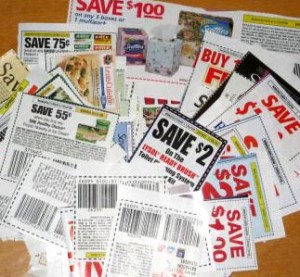Yesterday I read an article over at Life as a CEO about her grocery bills and how expensive they are becoming. It got me thinking about my families shopping habits and our grocery expenses and how much we spend on food on a monthly basis.
Yesterday I went food shopping early at Shop Rite because there were a few good items on sale that I didn’t want to miss like $1.99 Blue Bunny Ice Cream quarts and 4 for $8 General Mills Cereals. My kids eat a TON of cereal so I wanted to buy 8 boxes. Thankfully Melinda found a bunch of coupons online saving me $6. So for 8 boxes of ceral I spent $1.25 per box which is an awesome price.
The one thing Melinda and I have been trying to do lately is look through the entire store circular and use coupons so that we can try to save as much money as we can. Yesterday Melinda also started back up her weekly meal planning which in my opinion is a money saver because we know what we are having for dinner everyday and it saves us from having to order out. Preplanning is so important in saving money on food because I find if you need to go to the store more then once in a week you will be in big trouble. You will buy things that might be on sale but not on your list and items that you may not necessiarly need.
Below are 10 tips provided by Consumer savings expert, Andrea Woroch to help you with the increase in food prices:
1. Shop Warehouse Stores
Not all prices are better at membership stores, particularly if you tend to go overboard, but there are some really good deals to be had. Look for great buys on perishable items and shop towards the end of the day, when department managers want to unload extra inventory.
2. Use Coupons
Now’s the time to get in on the extreme-couponing trend, particularly since there are so many ways to access them these days. You’ll find coupons online in both Internet-code or downloadable (IP) form.. Mobile coupons are as close as your cell phone. CellFire is a great source for grocery savings.
Don’t overlook the coupons that print out with your receipt at the register. Known as Catalinas, these coupons are targeted towards the purchases you’ve made that day. Some stores, like King Soopers, also allow you to stack manufacturer and store coupons for additional savings. Not all supermarkets allow you to stack, however, so check first.
3. Hit Dollar Stores
Whether you cruise the narrow aisles of Dollar General or hit one of the smaller chains, dollar stores offer “ka-ching” savings on boxed, bagged and canned goods. Make sure you check the expiration dates, however.
4. Use Grocery Store Rewards Cards These loyalty cards have become a necessity to access store sales, but they also have another benefit; You can download online coupons directly to your rewards card and the savings will be taken off at the register. Visit the rewards-card pages of such supermarket websites as Safeway and Food Lion to find these manufacturer coupons.
Some rewards card also provide gas savings when you buy groceries. At times, King Soopers has taken up to 10-cents off each gallon you purchase at their pumps when you spend $100 or more in their store.
5. Buy Generic
By and large, store-brand generics can be much cheaper than manufacturer products with the exact same quality. In fact, generics come off the same assembly line before being slapped with separate labels so skip the brand name items.
6. Use Discount Gift Cards
Shop websites like GiftCardGranny for discount gift cards from Kmart, Walmart and other major chains that sell food goods and produce. Paying just a portion of the card’s face value gives you an instant savings on your grocery needs.
7. Make A List
Avoid impulse purchases by making a list before you leave home and sticking to it when you hit the store. Knowing specifically what you need also helps avoid duplications of products you already have at home.
8. Plan Your Meals
It’s a lot easier to make a list when you have a plan. Creating a weekly menu also helps you avoid quick trips to the supermarket that end up costing you more in many ways. For last minute meals, create a gourmet dish at a deep discount by buying meats, produce and other food items that are on sale at your local grocery store.
9. One-Stop Shop Save gas, time and money by shopping stores like Target that allow you to buy everything on your list within one visit.
10. Avoid Out-of-Season Produce To every vegetable and fruit there is a season…and a better price. Squash are cheaper in the fall while asparagus can be a bargain in the spring. Wait until prices are at their best and plan your menu around seasonal produce to save big.
Melinda and I try to do everything above to save every dollar we can. We go to the grocery store every week and to BJ’s Wholesale club once a month so the money starts to add up.
What do you do to save money on food?
This is NOT a sponsored post but the 10 tips listed above were provided by Consumer savings expert, Andrea Woroch.


























